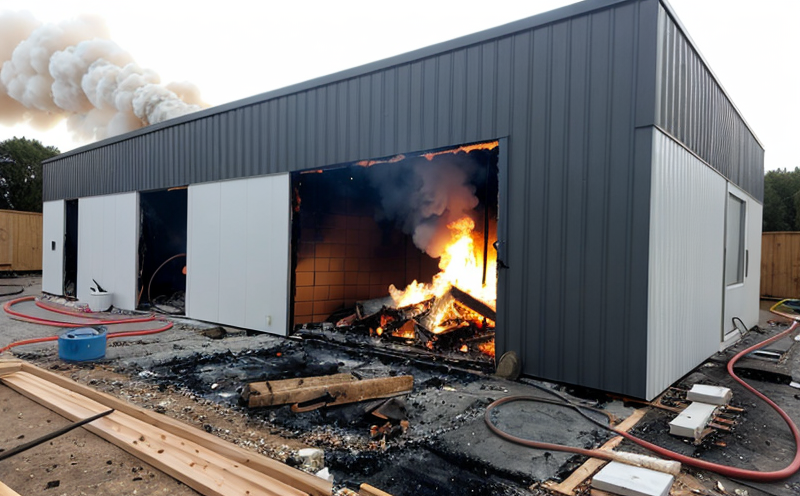Fire Propagation Testing of Exterior Insulation and Finish Systems (EIFS)
The Fire Propagation Testing of Exterior Insulation and Finish Systems (EIFS) is a critical service offered to ensure the safety and compliance of buildings. EIFS are composite systems comprising an exterior insulation layer, a structural substrate, and a finish coat that can be painted or textured. These systems are widely used in construction due to their versatility and aesthetic appeal but must meet stringent fire safety standards.
Fire propagation testing for EIFS involves assessing the performance of these systems under controlled laboratory conditions according to international standards such as ISO 13501-2, ASTM E84, or EN 13679. The primary goal is to determine the fire resistance and behavior of EIFS components when exposed to flames. This testing helps in ensuring that the materials used are safe and comply with local building codes and regulations.
During the test, a specimen of the EIFS system is placed on a vertical surface and subjected to an applied flame for a specified duration. The parameters measured include the distance traveled by the flame along the surface, the time it takes for the fire to spread, and the amount of smoke produced. These metrics are crucial in assessing the fire performance of the material.
The testing procedure is designed to simulate real-world scenarios where EIFS might be exposed to fire hazards. By adhering to these rigorous standards, architects, contractors, and safety officers can have confidence that the buildings they design and construct will meet the highest safety standards.
- Compliance Assurance: Ensures that materials used in EIFS systems comply with relevant international standards.
- Risk Reduction: Identifies potential fire hazards early on, allowing for necessary modifications to be made before installation.
The results of the testing are detailed and comprehensive, providing a clear picture of how well the EIFS performs under fire conditions. These reports are essential tools for architects, engineers, and safety officers in making informed decisions about material selection and design.
Why It Matters
The importance of fire propagation testing for EIFS cannot be overstated, especially given the increasing complexity of modern building materials. Fire safety is a critical factor in ensuring public health and property protection. Non-compliant materials can lead to significant risks during fires, including rapid spread of flames, release of toxic gases, and structural damage.
Regulatory bodies around the world have stringent requirements for fire testing due to the potential hazards associated with non-compliant building materials. For instance, in the United States, the International Code Council (ICC) requires that all exterior wall assemblies be tested according to ASTM E84 or EN 13679. Similar regulations are enforced by other countries like Australia and Canada.
The results of fire propagation testing for EIFS provide valuable insights into the performance characteristics of these systems under controlled laboratory conditions. This information is crucial for architects, designers, and builders who need to select materials that not only meet aesthetic and functional requirements but also ensure safety in case of a fire emergency.
Applied Standards
The testing of EIFS for fire propagation typically adheres to several internationally recognized standards. These include:
- ISO 13501-2:2016 – This standard specifies the method for determining the surface spread of flame on building materials and products using the surface-flame test.
- ASTM E84-17a – This American Society for Testing Materials (ASTM) standard describes a smoke development index test that measures both flame spread and smoke production from materials.
- EN 13679:2005 – This European Norm specifies the method for determining the surface spread of fire on building materials and products using the channel flame test.
These standards provide a framework for testing that ensures consistency in results across different laboratories. Compliance with these standards is essential to ensure that EIFS materials are safe and effective in real-world applications.
Benefits
- Enhanced Safety: Ensures that the materials used in EIFS systems comply with strict fire safety regulations, thereby enhancing building safety.
- Risk Mitigation: Identifies potential risks early on and allows for necessary modifications to be made before installation.
- Regulatory Compliance: Helps architects and builders meet local and international fire safety standards.
- Confidence in Design: Provides designers with reliable data that can inform material selection and design decisions.
By conducting fire propagation testing, stakeholders involved in the construction industry can make informed choices about materials that ensure both aesthetic appeal and functional performance while maintaining high safety standards.





